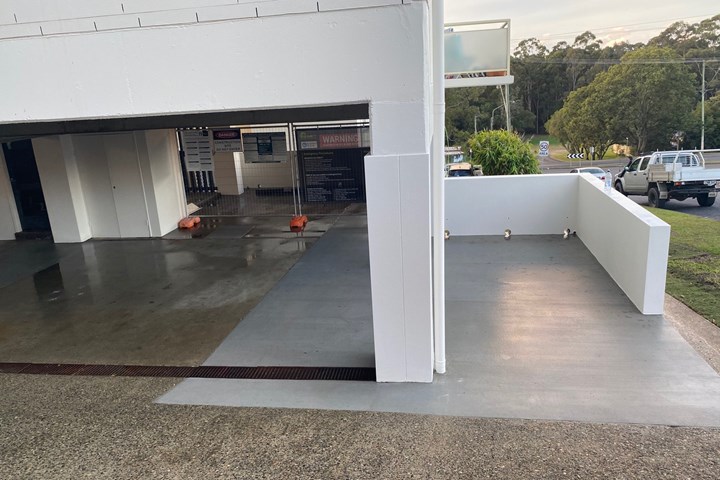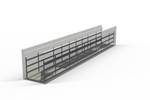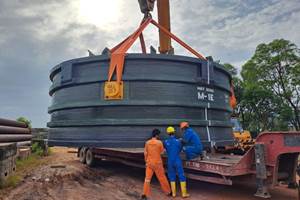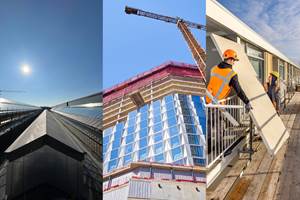ATL Composites contributes to concrete pillar remediation project
Six new support pillars incorporate Hexcel ZU300 UD carbon fiber and ATL’s Technirez R2517 epoxy resin with H2431 slow hardener that will protect against storm water issues.

Photo Credit: ATL Composites
It was reported on Nov. 18 that ATL Composites (Molendinar, Australia) was recently involved in a remediation project on a unit block in Coffs Harbour, Australia, with (Quebec, Canada) and engineers. The project’s goal, to repair and reinforce the 40-year-old concrete pillars supporting the entire building, used high-performance carbon fiber composites to get the job done. A majority of them were suffering from concrete cancer, a result of exposure to the sea air and wear and tear over many decades.
Binet Constructions has a 50-year history in the Coffs region; however, using composites as the repair material was still relatively new to the company. “We hadn’t used carbon fiber on construction projects before, but it was specified by the engineer and we believed it would be perfect for the job,” says Murray Binet, the son of founder, Greg Binet. The Binets had previously worked with ATL epoxies, E- fiberglass reinforcements and DuFLEX composite panels in the construction of an 11-meter Schionning catamaran.
Binet Constructions first sent the specs for the resin and carbon to ATL’s Anthony Basilone, who suggested ZU300, a high-performance unidirectional (UD) carbon fiber material manufactured by Hexcel Corp. (Stamford, Conn., U.S.) and ATL’s Technirez R2517 epoxy resin with H2431 slow hardener to laminate the reinforcement.
“We see much more potential applications for this product and technique, specifically the remediation of bridges, buildings and other construction projects.”
Techniglue R60 structural adhesive thickened with WEST SYSTEM 413 Microfibre Blend was also used as a surface filler on the patched concrete, to provide a flat surface for the carbon to bond to. Synthetic peel-ply was used to wrap the carbon reinforcement in order to provide a textured surface that would reduce the amount of sanding required prior to the application of the final finish.
The apartment block comprised 16 units in a four-story building. There were six columns in the car park in the basement of the building that required repairs. Each pillar supported 60 tonnes.
According to Murray Binet, the most challenging part of the work was “creating the new support structure in a 40-year-old building. The building had long-term storm water issues as well.”
Despite this, ATL’s carbon fiber reinforcements and Technirez structural epoxy were said to be ideal for the job. “They’re lightweight, easy to work with, watertight when glued on and strong,” Binet adds. “In fact, the combination of the ATL products exceeded the engineer’s specifications.”
ATL’s Anthony Basilone explains, “The engineers decided on a specification where the original pylons were to be ground back to good material, patched with a mortar mix, wrapped in epoxy/carbon and then an additional pylon added to increase the overall strength. The carbon wrapping was used to ensure the old pylon would last as long as the new ones.”
The benefit of this procedure, rather than removing the pillars and replacing them was that residents didn’t have to move out while the building underwent major construction work.
“Removing the pylons, reinforcing the foundations with lintels would have been a huge undertaking, resulting in relocation of residents, added expense and a loss of rental income for owners. It was certainly more cost-effective, quicker and less hassle all round,” says Murray.
“The carbon fiber product from ATL was excellent,” he adds. “We see much more potential applications for this product and technique, specifically the remediation of bridges, buildings and other construction projects.”
Related Content
Swedish parking garage to incorporate decommissioned wind blades
Architect Jonas Lloyd is working with Vattenfall to design the multistory building with a wind blade façade, targeting eco-friendly buildings and creative ways to remove blades from landfills.
Read MoreRenco USA brings Lego-style composite building system to construction
After more than a decade dedicated to R&D, evaluation and testing, the company has proven its MCFR building system in a Lakewood Village project in Florida.
Read MoreComposites end markets: Infrastructure and construction (2024)
Composites are increasingly used in applications like building facades, bridges, utility poles, wastewater treatment pipes, repair solutions and more.
Read MoreBio-based, fire-resistant composites become mainstream
Projects use Duplicor prepreg panels with highest Euroclass B fire performance without fire retardants for reduced weight, CO2 footprint in sustainable yet affordable roofs, high-rise façades and modular housing.
Read MoreRead Next
WEAV3D composite material approved for infrastructure reinforcement applications
Durable, strong and resistant to corrosion, the thermoplastic-based lattice material is suitable for use in Oldcastle Infrastructure’s polymer concrete and sheet molding compound (SMC) composite products.
Read MoreCutting 100 pounds, certification time for the X-59 nose cone
Swift Engineering used HyperX software to remove 100 pounds from 38-foot graphite/epoxy cored nose cone for X-59 supersonic aircraft.
Read MoreCeramic matrix composites: Faster, cheaper, higher temperature
New players proliferate, increasing CMC materials and manufacturing capacity, novel processes and automation to meet demand for higher part volumes and performance.
Read More












